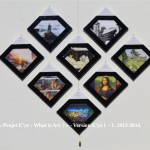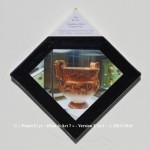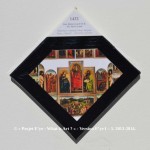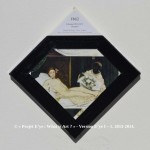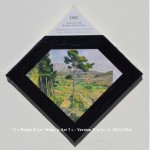The Pitch : Art in a wink of eye – The portable museum
Make a ” portable, universal museum ” circulate in town. The public does not have time to go to the museum, it is thus the museum which goes to their place.
SUMMURY :
Imagine the most important artists in the world.
Imagine that they gathered together, in the same place, at the same time ;
Imagine that they are registered, in the most « perfect » form : an installation in Diamond shape.
How it can be ?
- « E’ye : What is art ? » Version I – 1 : 1 – 8.
- « E’ye : What is art ? » Version I – 1 : 9 – 16.
- « E’ye : What is art ? » Version I – 1 : 1 – 16.
- I – 1. 1. 22.000 av. J.C. – Lascaux. / 22.000 bef. J.C. Lascaux.
- I – 1. 2. 560 Av. J.C. – Vase François. / 560 Bef. J.C. François Vase
- I – 1. 3. 62 av. J.C. – Villa des Mystères. / 62 bef. J.C. Villa of the Mysteries.
- I – 1. 4. 425 – Le Bon Pasteur. / The Good Shepherd.
- I – 1. 5. 1412 – Les Très Riches Heures du duc de Berry. Janvier ./ January.
- I – 1. 6. 1432 – L’agneau Mystique . / Adoration of the Mystic Lamb.
- I – 1. 7. 1483-86 – Le Printemps. / La Primavera.
- I – 1. 8. 1514 – Melancholia I.
- I – 1. 9. 1817-18 – Voyageur contemplant une mer des nuages. / Wanderer above the Sea of Fog.
- I – 1. 10. 1826 – Point de vue du Gras . / View from the Window at Le Gras.
- I – 1. 11. 1840 – Le Négrier. / The Slave Ship.
- I – 1. 12. 1850 – Olympia.
- I – 1. 13. 1882-85 – La Montagne Sainte-Victoire. / The Mountain Sainte-Victoire.
- I – 1. 14. 1897-98 – D’où venons-nous ? Que sommes-nous ? Où allons-nous ? / Where Do We Come From ? What Are We ? Where Are We Going ?
- I – 1. 15. 1965 – L.H.O.O.Q., Rasée. / L.H.O.O.Q., Shaved.
- I – 1. 16. 2012 – Tout Meurt. / Everything Dies.
- « E’ye : What is art ? » I – 1 & 2
- E’ye II, III & IV Représentation schématique / Schematic representation
The project « E’ye : What is Art ? » is an original and very appealing project, because it exceeds the limits and the borders of Art, to reach in a new artistic proposal, both at the level of the form and content.
A « Never seen before » project, which declines under the form of an Installation, both light and monumental.
The current file is a summary composed of six parts. It is certainly the best way to capture the many challenges of the project.
* * *
I – The project « E’ye : What is Art ? » : A triple « World Premiere »
I. 1. The Temporality
I. 2. The Formality
I. 3. The Fusion
II. 1. The question of copyright ; II. The first text which outlines the project
III. The Two periods : Before and After the III millennium
IV. The version « E’ye I » concerns only the universe of the painting.
V. The two versions of ProjeCt « E’ye » I – 1 & 2 – The question of the edges of the work
VI. Future versions of the Project « E’ye » : « E’ye II, III & IV. »
* * *
I – The project « E’ye : What is Art ? » : A triple « World Premiere » »
I am interested in « new » and in the experiment of the « new ». As soon as we pull a wire of the ball of the new, all which appears in front is new. For example, to contact artists, to visualise their works, to transform them (slightly), to associate works, to reframe them. All these actions are new. So, the project « E’ye : What is Art ? » Inaugurate a triple world premiere :
* * *
I. 1. The Temporality
The quality of ubiquity (of the Latin « ubique » which means « everywhere »), in our case to
visualise in a single place, and a single moment, a significant panorama of artworks relevant to the History of Art. Usually, we rarely work on the thickness of time.
* * *
I. 2. The Formality
Even today, the supports of painted works of art in two dimensions, remain, if one dares to say, « rectanglophile », they are often industrial frames right-angled or square, manufactured in series. We can estimate at 85% the percentage of works with right angles.
The project « E’ye :What is Art ? » propose the « Diamond » shape. A pure form who suggests many significances.
* * *
I. 3. The Fusion
It is about the fusion of other artists’ works, we mentioned it above.
There are moreover other qualities, like the second reading (re-writing) of an artwork, or
Globality (interest in a « whole »).
* * *
II. 1. The question of copyright ; II. The first text which outlines the project.
The project divides in two big periods : 1. Before the IIIrd millennium ; 2. After the IIIrd millennium. With regard to the first period, I drew from authors whose artworks are in the « public domain ». For the second period, I needed an « authorisation » of the artists. I thus visited hundreds of sites, I choose artists who are ready to embark on this new adventure.
I thank, on the way, the generosity of the artists who accepted the idea of the project : Rosendal Rafael (Holland), Bailly-Maître-Grand Patrick (France), Liberato Ricardo (Italy), Hovagimyan G.H.
(USA), Jaskula Natalia (Poland), Kunc Milan (Czech Republic), Gautam Narang (Great-Britain).
I would like also to thank the following photographers : 120 (Vincent Mourre), Aavindra, Boo Boo Baroo, Cybershot800i, Descouens Didier, Ed g2s, Edgar Allan Poe, Erzalibilas, Gisleh, Google Art Project, Jastrow, Lücking Heinz-Josef, Mathknight, Mossot, Prof Saxx, Sailko, The York Project, Xanthou Onyx)
(Cf. https://www.projet-e3.com/links/)
* * *
II. The first text which outlines the project
(At the conclusion of the 1st letter, and at the request of the curious artists, I sent the following text with other explanations)
Objet : Projet « E’ye : What is Art ? »
On May 29, 2013
The « E’ye Project: What is Art ? » Is an original and unique monumental installation, which is still experimental and under study : it is the phase of realization of two versions : « E’ye I » and « E’ye II ». The project is still secret, but I count soon to present it to international (public and private) institutions. What I can say is that the project has remarkable visual and semantic features. For example, it has a quality of “elasticity”, it adapts to the space for which it is intended, as I hope, the final installation, « E’ye III », is destined to become “an international traveling exhibition.” Already, I prepare a list of public and private institutions on the five continents.
I have great conviction that this project can not be ignored, because it responds perfectly to the crucial question : « What is Art ? » It cannot be ruled out for several reasons. First, it offers from the starts, a immediate and comprehensive “response”, it is ultra-direct according to the asked question, and at the same time, the project implies an iconoclastic load. This is already not negligible.
It is very relevant to an audience that has difficult to “feel” the Contemporary Art
Then, among the components of Installation, a perfect plastic form is detached : a diamond. Finally, it combines a clear combination of the data plastics, formal, aesthetic, semantic and pedagogical.
Dr. Dimitri Dimitriadès
(Eoésis)© Lettr’E Diamant
III. The Two periods : Before and After the III millennium
The 1st period is divided into four parts which are the following ones:
| Period 1 | Before the IIIrd millennium | Periods | Historical divisions |
|---|---|---|---|
| 01 | 30,000 BC. J. C. →100 BC. J.C. | Fundamentals of Art → Greek art | |
| 02 | 100 BC. J.C. → 1100 AD. J.C. | Greece and its influence → Sacred Art | |
| 03 | 1200 →1800 | Emergence of the modern world | |
| 04 | 1800 → 1910 | Les Arts du XIX ème et XX ème siècle | |
| Period II | After the IIIrd millennium | 1980 → 2013 | Contemporary Art |
* * *
IV. The version « E’ye I » concerns only the universe of the painting
Each version is a multiple of eight (or four) canvas and adapts spaces. It may therefore be either 2 x 8 = 16 (the example shown), or 4 x 8 = 32, or 64 = 8 x 8 or 4 x 32 = 128.
The first version of “E’ye: What is Art? “(2 x 8 canvas) concerns exclusively the universe of painting, because it was impossible to provide a comprehensive overview of art with only 16 pieces. However there are some exceptions, such as the piece 10 which corresponds to the photography, with the first picture in the history of photography of Nicephore Niepce or the piece 15 a “ready-made” of Marcel Duchamp.
In the following versions, we include all the visual arts, namely :
1. Painting ;
2. Sculpture;
3. Architecture;
4. Others (Photography, cinema, design)
| Year | Period | Artists | Work title | |
|---|---|---|---|---|
| 01 | 20.000 bef. J.C. | XXth millennium | Unknown | Bulls Head Lascaux |
| 02 | 560 bef. J. C. | VI ème bef. J.C. | Clitias, Ergotimos | François Vase |
| 03 | 50 bef. J. C. | I er bef. J.C. | Unknown | Villa of the Mysteries Pompei |
| 04 | 425 | V th century | Unknown | Good Shepherd |
| 05 | 1411-1416 | XIV th century | Limbourg Brothers | Les Très Riches Heures du Duc de Berry |
| 06 | 1432 | XV th century | Jan Van Eyck | The Mystic Lamb |
| 07 | 1477 | XV th century | Sandro Boticelli | The Spring |
| 08 | 1514 | XVI th century | Albrecht Dürer | Melancholia I |
| 09 | 1817-18 | XIX thcentury | Caspar David Friedrich | Wanderer above the Sea of Fog |
| 10 | 1826-27 | XIX th – 2 | Nicéphore Niepce | First Photo : Point of view of Gras |
| 11 | 1840 | XIX th – 3 | William Turner | The Slave Ship |
| 12 | 1850 | XIX th – 4 | Edouard Manet | Olympia |
| 13 | 1882-85 | XIX th – 5 | Paul Cézanne | The Mountain Sainte-Victoire |
| 14 | 1897-98 | XIX th – 6 | Paul Gauguin | Where Do We Come From? What Are We? Where Are We Going? |
| 15 | 1911(1965) | XX th century | Marcel Duchamp | L.H.O.O.Q., Shaved |
| 16 | 2012 | XXI th century | Rozendaal Rafael | Everything dies |
* * *
V. The two versions of « E’ye I. » – The question of the edges of the work
The borders of the Version “E’ye: What is Art? ” I – 1, are black.
The borders of the Version “E’ye: What is Art? ” I – 2 come according to the principle of the chromatic circle, namely: violet, blue, green, yellow, orange, red.
* * *
VI. Future versions of the Project « E’ye » : « E’ye II, III & IV. »
As I already said, each version is a multiple of eight (or four) canvas, installed according to the general configuration of a diamond.
It may therefore be either 2 x 8 = 16 (the example shown), or 4 x 8 = 32, or 64 = 8 x 8 or 4 x 32 = 128.
| Version | Number of canvas | Total umber of canvas | Dimension of canvas | Width of every module of 8 | Total width |
|---|---|---|---|---|---|
| « E’ye I » | 2 x 8 | 16 | 20 x 20 cm | 2 x 98cm | 196cm = 2 m. |
| « E’ye II » | 4 x 8 | 32 | 30 x 30 cm | 4 x 140cm | 560cm = 5.6m. |
| « E’ye III » | 8 x 8 | 64 | 40 x 40 cm | 8 x 186cm | 1488cm = 15m. |
| « E’ye IV » | 32 x 4 | 128 | 80 x 80 cm | 32 x 186cm | 4693cm = 47m. |
The ultimate objective is the realization either of the version “E’ ye V” ( 256 canvas), which will be the most complete. The list of the works is already done.
Let’s surprise the world in the blink of an eye.
Dimitri Dimitriadès
* * *
* * *

